  |
|
0 to 1500 AD |
1500 to 1600 AD |
1600 to 1700 AD |
1700 to 1800 AD 1800 to 1850 AD | 1850 to 1900 AD | 1900 to 1950 AD | 1950 to present |
  |
|
0 to 1500 AD |
1500 to 1600 AD |
1600 to 1700 AD |
1700 to 1800 AD 1800 to 1850 AD | 1850 to 1900 AD | 1900 to 1950 AD | 1950 to present |
| The following dates and
events were gathered from several sources. These
events are certainly not all of the important events to take place in
neuroscience...just some of the ones that I have selected.
4000 B.C. to 0 A.Dca. 4000 B.C. - Euphoriant effect of poppy plant reported in Sumerian recordsca. 4000 B.C. - Clay tablets from Mesopotamia discuss how to use alcohol to dilute medicine ca. 2700 B.C. - Shen Nung originates acupuncture ca. 1700 B.C. - Edwin Smith surgical papyrus written. First written record about the nervous system ca. 1400-1200 B.C. - Ayuvedic system of Hindu medicine develops ca. 600 B.C. - Indian physician Sushruta describes surgery for cataracts in Sushruta Samhita ca. 500 B.C. - Alcmaion of Crotona dissects sensory nerves ca. 500 B.C. - Alcmaion of Crotona describes the optic nerve ca. 500 B.C. - Empedocles suggests that "visual rays" cause sight 460-379 B.C. - Hippocrates discusses epilepsy as a disturbance of the brain 460-379 B.C. - Hippocrates states that the brain is involved with sensation and is the seat of intelligence 387 B.C. - Plato teaches at Athens. Believes brain is seat of mental process 335 B.C. - Aristotle writes about sleep; believes heart is seat of mental process 335-280 B.C. - Herophilus (the "Father of Anatomy"); believes ventricles are seat of human intelligence 280 B.C. - Erasistratus of Chios notes divisions of the brain |
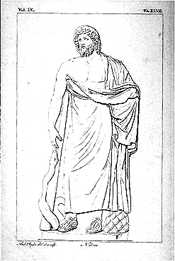 Hippocrates Image courtesy of the Blocker History of Medicine Collections, Moody Medical Library, Univ. Texas Med. Branch, Galveston |
0 A.D. to 1500177 - Galen lecture On the Brainca. 100 - Marinus describes the tenth cranial nerve ca. 100 - Rufus of Ephesus describes and names the optic chiasm ca. 390 - Nemesius develops the doctrine of the ventricular localization of all mental functions ca. 900 - Rhazes describes seven cranial nerves and 31 spinal nerves in Kitab al-Hawi Fi Al Tibb ca. 1000 - Ammar ibn Ali of Mosul extracts cataract from the eye ca. 1000 - Alhazen compares the eye to a camera-like device ca. 1000 - Al-Zahrawi (also known as Abulcasis or Albucasis) describes several surgical treatments for neurological disorders 1021 - Ibn Al-Haytham (Alhazen) publishes Book of Optics 1025 - Avicenna writes about vision and the eye in The Canon of Medicine 1088 - Abu Ruh writes The Light of the Eyes describing several eye operations 1260 - Louis IX founds the Hopital des Quinze-Vingts, the first institution for the blind 1284 - Salvino D'Armate constructs eyeglasses 1316 - Mondino de'Luzzi writes the first European anatomy textbook (Anothomia) 1402 - St. Mary of Bethlehem Hospital is used exclusively for the mentally ill 1410 - Institution for the mentally ill established in Valencia, Spain |
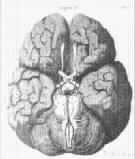 Image
courtesy of the National Library of Medicine, |
1500 - 16001501 - Magnus Hundt uses the word "cerebellum" to describe the posterior division of the brain in Anthropologia1504 - Leonardo da Vinci produces wax cast of human ventricles 1536 - Nicolo Massa describes the cerebrospinal fluid 1538 - Andreas Vesalius publishes Tabulae Anatomicae 1542 - Jean Fernel publishes De naturali parte Medicinae that contains the term "physiology" for the first time 1543 - Andreas Vesalius publishes On the Workings of the Human Body 1543 - Andreas Vesalius discusses the pineal gland and draws the corpus striatum 1549 - Jason Pratensis publishes De Cerebri Morbis, an early book devoted to neurological disease 1550 - Vesalius describes hydrocephalus 1550 - Bartolomeo Eustachio describes the brain origin of the optic nerves 1558 - Giambattista della Porta describes wooden hearing aids in his book Natural Magick 1561 - Gabriele Falloppio publishes Observationes Anatomicae and describes some of the cranial nerves. Separate trochlear and abducens nerves identified 1562 - Bartolomeo Eustachio publishes The Examination of the Organ of Hearing 1564 - Giulio Cesare Aranzi coins the term hippocampus 1573 - Constanzo Varolio names the pons 1573 - Constanzo Varolio is first to cut brain starting at its base 1573 - Girolamo Mercuriali writes De nervis opticis to describe optic nerve anatomy 1583 - Felix Platter states that the lens only focuses light and that the retina is where images are formed 1583 - Georg Bartisch publishes Ophthalmodouleia: das ist Augendienst with drawings of the eye 1586 - A. Piccolomini distinguishes between cortex and white matter 1587 - Guilio Cesare Aranzi describes ventricles and hippocampus. He also demonstrates that the retina has a reversed image 1590 - Zacharias Janssen invents the compound microscope 1596 - Sir Walter Raleigh mentions arrow poison in his book Discovery of the Large, Rich and Beautiful Empire of Guiana |
 Leonardo Da Vinci
Image courtesy of the Blocker History of Medicine Collections, Moody Medical Library, Univ. Texas Med. Branch, Galveston |
1600 - 17001601 - Hieronymus Fabricius ab Aquapendente publishes Tractatus de Oculo Visusque Organo describing the correct location of the lens relative to the iris1604 - Johannes Kepler describes inverted retinal image 1609 - J. Casserio publishes first description of mammillary bodies 1611 - Lazarus Riverius textbook describing impairments on consciousness published 1621 - Robert Burton publishes The Anatomy of Melancholy about depression 1623 - Benito Daca de Valdes publishes the first book on vision testing and eyeglass-fitting 1627 - William Harvey demonstrates a role of the brain in frog movement 1641 - Franciscus de la Boe Sylvius describes fissure on the lateral surface of the brain (Sylvian fissure) 1644 - Giovanni Battista Odierna describes the microscopic appearance of the fly eye in L'Occhio della Mosca 1649 - Rene Descartes describes pineal as control center of body and mind 1650 - Franciscus de la Boe Sylvius describes a narrow passage between the third and fourth ventricles (the aqueduct of Sylvius) 1658 - Johann Jakof Wepfer theorizes that a broken brain blood vessel may cause apoplexy (stroke) 1661 - Thomas Willis describes a case of meningitis 1662 - Rene Descartes De homine is published (He died in 1650) 1664 - Thomas Willis publishes Cerebri anatome (in Latin) 1664 - Thomas Willis describes the eleventh cranial nerve (accessory nerve) 1664 - Thomas Willis suggests that cerebrospinal fluid is produced by the choroid plexus 1664 - Gerardus Blasius discovers and names the "arachnoid" 1664 - Jan Swammerdam causes frog muscle contraction by mechanical stimuation of nerve 1665 - Robert Hooke details his first microscope 1667 - Robert Hooke publishes Micrographia 1668 - l'Abbe Edme Mariotte discovers the blind spot 1670 - William Molins names the trochlear nerve 1671 - Franciscus de la Boe Sylvius describes the septum pellucidum 1673 - Joseph DuVerney uses experimental ablation technique in pigeons 1681 - English edition of Thomas Willis' Cerebri anatome is published 1681 - Thomas Willis coins the term Neurology 1684 - Raymond Vieussens publishes Neurographia Universalis 1684 - Raymond Vieussens uses boiling oil to harden the brain 1686 - Thomas Sydenham describes a form of chorea in children and young adults 1695 - Humphrey Ridley describes the restiform body 1695 - Humphrey Ridley publishes The Anatomy of the Brain 1696 - John Locke writes Essay Concerning Human Understanding 1697 - Joseph G. Duverney introduces the term "brachial plexus" |
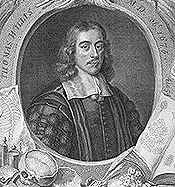 Thomas Willis Image courtesy of the Blocker History of Medicine Collections, Moody Medical Library, Univ. Texas Med. Branch, Galveston |
1700 - 18001704 - Antonio Valsalva publishes On the Human Ear1705 - Antonio Pacchioni describes arachnoid granulations 1709 - Domenico Mistichelli describes the pyramidal decussation 1709 - George Berkeley publishes New Theory of Vision 1717 - Antony van Leeuwenhoek describes nerve fiber in cross section 1721 - The word "anesthesia" first appears in English (in Dictionary Britannicum) 1727 - Edward Scarlett develops eyeglasses held by arms that hook over the ears 1736 - Jean Astruc coins the term reflex 1740 - Emanuel Swedenborg publishes Oeconomia regni animalis 1749 - David Hartley publishes Observations of Man, the first English work using the word "psychology" 1750 - Jacques Daviel performs the first cataract extraction on a living human eye 1752 - The Society of Friends establishes a hospital-based environment for the mentally ill in Philadelphia 1755 - J.B. Le Roy uses electroconvulsive therapy for mental illness 1760 - Arne-Charles Lorry demonstrates that damage to the cerebellum affects motor coordination 1764 - Domenico F.A. Cotugno describes spinal subarachnoid cerebrospinal fluid; shows that ventricular and spinal fluids are connected 1764 - The interventricular foramen (Foramen of Monroe) is named after Alexander Monroe; it was described earlier by Vieussens 1766 - Albrecht von Haller provides scientific description of the cerebrospinal fluid 1772 - John Walsh conducts experiments on torpedo (electric) fish 1773 - John Fothergill describes trigeminal neuralgia (tic douloureux, Fothergill's syndrome) 1773 - Sir Joseph Priestley discovers nitrous oxide 1774 - Franz Anton Mesmer introduces "animal magnetism" (later called hypnosis) 1776 - M.V.G. Malacarne publishes first book solely devoted to the cerebellum 1777 - Philip Meckel proposes that the inner ear is filled with fluid, not air 1778 - Samuel Thomas von Soemmerring presents the modern classification of the twelve cranial nerves 1779 - Antonius Scarpa describes Scarpa's ganglion of the vestibular system 1780 - Etienne Bonnot de Condillac publishes the first figure of "reflex action" 1781 - Felice Fontana describes the microscopic features of axoplasm from an axon 1782 - Francesco Gennari publishes work on "lineola albidior" (later known as the stripe of Gennari) 1782 - Francesco Buzzi identifies the fovea 1783 - Alexander Monro describes the foramen of Monro 1784 - Benjamin Rush writes that alcohol can be an addictive drug 1784 - Benjamin Franklin mentions bifocal eyeglasses in a letter to George Whatley 1786 - Felix Vicq d'Azyr discovers the locus coeruleus 1786 - Samuel Thomas Sommering describes the optic chiasm 1786 - Georg Joseph Beer founds the first eye hospital in Vienna 1790 - Johannes Ehrenritter describes the glossopharygeal nerve ganglion 1791 - Luigi Galvani publishes work on electrical stimulation of frog nerves 1791 - Samuel Thomas von Soemmering names the macula lutea of the retina 1792 - Giovanni Valentino Mattia Fabbroni suggests that nerve action involves both chemical and physical factors 1796 - Johann Christian Reil describes the insula (island of Reil) 1798 - John Dalton, who was red-green colorblind, provides a scientific description of color blindness |
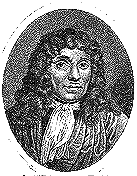 Antony van Leeuwenhoek
Images courtesy of the Blocker History of Medicine Collections, Moody Medical Library, Univ. Texas Med. Branch, Galveston |
1800 - 1850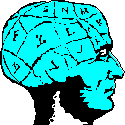 1800 - Alessandro Volta invents the wet cell battery
1800 - Alessandro Volta invents the wet cell battery1800 - Humphrey Davy synthesizes nitrous oxide 1800 - Samuel von Sommering identifies black material in the midbrain and calls it the "substantia nigra" 1801 - Thomas Young describes astigmatism 1801 - Adam Friedrich Wilhelm Serturner crystalizes opium and obtains morphine 1801 - Philippe Pinel publishes "A Treatise on Insanity" 1802 - Thomas Young suggests the three types of retinal receptors are sufficient for color vision 1808 - Franz Joseph Gall publishes work on phrenology 1809 - Johann Christian Reil uses alcohol to harden the brain 1809 - Luigi Rolando uses galvanic current to stimulate cortex 1811 - Julien Jean Legallois discovers respiratory center in medulla 1811 - Charles Bell discusses functional differences between dorsal and ventral roots of the spinal cord 1812 - Benjamin Rush publishes Medical Inquiries and Observations upon the Diseases of the Mind 1813 - Felix Vicq d'Azyr discovers the claustrum 1817 - James Parkinson publishes An Essay on the Shaking Palsy 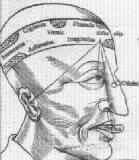 1818 - Library of the Surgeon General's Office established (later to
become the Army Medical Library and then the National Library of
Medicine)
1818 - Library of the Surgeon General's Office established (later to
become the Army Medical Library and then the National Library of
Medicine)1820 - Galvanometer invented 1821 - Charles Bell describes facial paralysis ipsilateral to facial nerve lesion (Bell's palsy) 1821 - Francois Magendie discusses functional differences between dorsal and ventral roots of the spinal cord 1822 - Friedrich Burdach names the cingular gyrus 1822 - Friedrich Burdach distinguishes lateral and medial geniculate 1823 - Marie-Jean-Pierre Flourens states that cerebellum regulates motor activity 1824 - John C. Caldwell publishes Elements of Phrenology 1824 - Marie-Jean-Pierre Flourens details ablation to study behavior 1824 - F. Magendie provides first evidence of cerebellum role in equilibration 1825 - John P. Harrison first argues against phrenology 1825 - Jean-Baptiste Bouillaud presents cases of loss of speech after frontal lesions 1825 - Robert B. Todd discusses the role of the cerebral cortex in mentation, corpus striatum in movement and midbrain in emotion 1825 - Luigi Rolando describes the sulcus that separates the precentral and postcentral gyri 1826 - Johannes Muller publishes theory of "specific nerve energies" 1827 - E. Merck & Company market morphine 1832 - Justus von Liebig discovers chloral hydrate 1832 - Jean-Pierre Robiquet isolates codeine 1832 - Massachusetts establishes a "State Lunatic Hospital" for the mentally ill 1832 - Sir Charles Wheatstone invents the stereoscope 1833 - Philipp L. Geiger isolates atropine 1834 - Ernst Heinrich Weber publishes theory of "Just Noticeable Difference" or "Weber's Law" 1836 - Marc Dax reads paper on left hemisphere damage effects on speech 1836 - Gabriel Gustav Valentin identifies neuron nucleus and nucleolus 1836 - Robert Remak describes myelinated and unmyelinated axons 1836 - Charles Dickens (the novelist) describes obstructive sleep apnea 1837 - Jan Evangelista Purkyne (Purkinje) describes large cerebellar cells with many branching dendrites Purkinje cells; identifies neuron nucleus and processes 1837 - The American Physiological Society is founded 1838 - Robert Remak suggests that nerve fiber and nerve cell are joined 1838 - Theordor Schwann describes the myelin-forming cell in the peripheral nervous system ("Schwann cell") 1838 - Jean-Etienne-Dominique Esquirol publishes Des Maladies Mentales, possibly the first modern work about mental disorders 1838 - Napoleonic Code leads to the requirement of facilities for the mentally ill 1838 - Eduard Zeis publishes study about dreams in people who are blind 1839 - Theodor Schwann proposes the cell theory 1839 - C. Chevalier coins the term microtome 1839 - Francois Leuret names the Rolandic sulcus for Luigi Rolando 1840 - Filippo Pacini describes the Pacinian corpuscle 1840 - Moritz Heinrich Romberg describes a test for conscious proprioception (Romberg test) 1840 - Adolph Hannover uses chromic acid to harden nervous tissue 1840 - Jules Gabriel Francois Baillarger discusses the connections between white and gray matter of cerebral cortex 1840 - Adolphe Hannover discovers the ganglion cells of the retina 1841 - Dorothea Lynde Dix investigates brutality within mental hospitals in the United States 1842 - Benedikt Stilling is first to study spinal cord in serial sections 1842 - Crawford W. Long uses ether on man 1842 - Francois Magendie describes the median opening in the roof of the fourth ventricle (foramen of Magendie) 1843 - James Braid coins the term "hypnosis" 1844 - American Psychiatric Association founded 1844 - Robert Remak provides first illustration of 6-layered cortex 1844 - Horace Wells uses nitrous oxide during a tooth extraction 1845 - Ernst Heinrich Weber and Edward Weber discover that stimulation of the vagus nerve inhibits the heart 1846 - William Morton demonstrates ether anesthesia at Massachusetts General Hospital 1847 - Chloroform anesthesia used by James Young Simpson 1847 - Chloroform anesthesia used by Marie Jean Pierre Flourens 1847 - American Medical Association is founded 1847 - The American Association for the Advancement of Science is founded 1848 - Phineas Gage has his brain pierced by an iron rod 1848 - First meeting of the American Association for the Advancement of Science 1848 - Richard Owen coins the word "notochord" 1849 - Hermann von Helmholtz measures the speed of frog nerve impulses |
1850 - 19001850 - Augustus Waller describes appearance of degenerating nerve fibers1850 - Marshall Hall coins the term spinal shock 1850 - Emil Du Bois-Reymond invents nerve galvanometer 1851 - Jacob Augustus Lockhart Clarke describes the nucleus dorsalis, an area in the intermediate zone of the spinal cord gray matter 1851 - Heinrich Muller is first to describe the colored pigments in the retina 1851 - Marchese Alfonso Corti describes the cochlear receptor organ in the inner ear (organ of Corti) 1851 - Hermann von Helmholtz invents ophthalmoscope 1851 - Andrea Verga describes the cavum vergae 1852 - A. Kolliker describes how motor nerves originate from the neurons in the anterior horn of the spinal cord 1852 - George Meissner and Rudolf Wagner describe encapsulated nerve endings later known as "Meissner's corpuscles" 1853 - William Benjamin Carpenter proposes "sensory ganglion" (thalamus) as seat of consciousness 1854 - Louis P. Gratiolet describes convolutions of the cerebral cortex 1855 - Bartolomeo Panizza shows the occipital lobe is essential for vision 1855 - Richard Heschl describes the transverse gyri in the temporal lobe (Heschl's gyri) 1856 - Albrecht von Graefe describes homonymous hemianopia 1857 - Charles Locock observes the anticonvulsive effects of potassium bromide 1858 - Joseph von Gerlach stains brain tissue with a carmine solution 1859 - Charles Darwin publishes The Origin of Species 1859 - Rudolph Virchow coins the term neuroglia 1859 - Hermann von Helmholtz publishes work on color blindness 1860 - Albert Niemann purifies cocaine 1860 - Gustav Theodor Fechner develops "Fechner's law" 1860 - Karl L. Kahlbaum describes and names "catatonia" 1861 - Paul Broca discusses cortical localization 1861 - T.H. Huxley coins the term calcarine sulcus 1862 - William Withey Gull describes clinical signs of syringomyelia 1862 - Hermann Snellen invents the eyechart with letters to test vision 1862 - Wilhelm Friedrich Kuhne demonstrates how motor nerves terminate in muscle cells 1863 - Foramen of Luschka named after Hubert von Luschka 1863 - Ivan Mikhalovich Sechenov publishes Reflexes of the Brain 1863 - Nikolaus Friedreich describes a progressive hereditary degenerative CNS disorder (Friedreich's ataxia) 1863 - Charter of the National Academy of Sciences signed by Abraham Lincoln 1864 - John Hughlings Jackson writes on loss of speech after brain injury 1865 - Otto Friedrich Karl Deiters differentiates dendrites and axons 1865 - Otto Friedrich Karl Deiters describes the lateral vestibular nucleus (Deiter's nucleus) 1866 - John Langdon Haydon Down publishes work on congenital "idiots" 1866 - Julius Bernstein hypothesized that a nerve impulse is a "wave of negativity" 1866 - Max Schultze discovers the two retinal receptors, rods and cones 1866 - Leopold August Besser coins the term "Purkinje cells" 1867 - Hermann von Helmholtz publishes Handbook of Physiological Optics 1867 - Joseph Lister reports his concept of antisepsis 1867 - Theodore Meynert performs histologic analysis of cerebral cortex 1868 - Julius Bernstein measures the time course of the action potential 1868 - Friedrich Goll describes the fasciculus gracilis 1869 - Francis Galton claims that intelligence is inherited (publication of Hereditary Genius) 1869 - Johann Friedrich Horner describes eye disorder (small pupil, droopy eyelid) later to be called "Horner's syndrome" 1870 - Eduard Hitzig and Gustav Fritsch discover cortical motor area of dog using electrical stimulation 1870 - Ernst von Bergmann writes first textbook on nervous system surgery 1871 - Gustav Fechner publishes work about synesthesia 1871 - Silas Weir Mitchell coins the term "phantom limb." 1872 - George Huntington describes symptoms of a hereditary chorea 1872 - Sir William Turner describes the interparietal sulcus 1872 - Charles Darwin publishes The Expression of Emotions in Man and Animals 1872 - Silas Weir Mitchell provides a clinical description of phantom limb pain 1873 - Camillo Golgi publishes first work on the silver nitrate method 1874 - Jean Martin Charcot describes amyotrophic lateral sclerosis 1874 - Vladimir Alekseyevich Betz publishes work on giant pyramidal cells 1874 - Roberts Bartholow electrically stimulates human cortical tissue 1874 - Carl Wernicke publishes Der Aphasische Symptomencomplex on aphasias 1875 - Sir David Ferrier describes different parts of monkey motor cortex 1875 - Richard Caton is first to record electrical activity from the brain 1875 - Wilhelm Heinrich Erb and Carl Friedrich Otto Westphal describe the knee jerk reflex 1876 - David Ferrier publishes The Functions of the Brain 1876 - Franz Christian Boll discovers rhodopsin 1876 - Francis Galton uses the term "nature and nurture" to explain "heredity and environment" 1877 - Jean-Martin Charcot publishes Lectures on the Diseases of the Nervous System 1878 - W. Bevan Lewis publishes work on giant pyramidal cells of human precentral gyrus 1878 - Claude Bernard describes nerve/muscle blocking action of curare 1878 - The first Ph.D. with "psychology" in its title is given to Granville Stanley Hall at Harvard University 1878 - Paul Broca publishes work on the "great limbic lobe" 1878 - W.R. Gowers publishes Unilateral Gunshot Injury to the Spinal Cord 1878 - Harmon Northrop Morse synthesized acetaminophen (paracetamol) 1878 - Louis-Antoine Ranvier describes regular interruptions in the myelin sheath (nodes of Ranvier) 1876 - David Ferrier publishes The Localization of Cerebral Disease 1879 - Camillo Golgi describes the "musculo-tendineous organs" (later to be know as the "Golgi tendon organs") 1879 - Mathias Duval introduces an improved method of embedding tissue using collodion 1879 - Hermann Munk presents detailed anatomy of the optic chiasm 1879 - William Crookes invents the cathode ray tube 1879 - Wilhelm Wundt sets up lab devoted to study human behavior 1879 - Scottish surgeon William Macewen performs successful surgery to treat a brain abscess 1880 - Jean Baptiste Edouard Gelineau introduces the word "narcolepsy" 1880 - Friedrich Sigmund Merkel describes free nerve endings later known as "Merkel's corpuscles" 1880 - Thomas Graydon invents the "Dentaphone," a bone conduction hearing device 1881 - Hermann Munk reports on visual abnormalities after occipital lobe ablation in dogs 1883 - Sir Victor Horsley describes effects of nitrous oxide anesthesia 1883 - Emil Kraepelin coins the terms neuroses and psychoses 1883 - George John Romanes coins the term "comparative psychology" 1883 - The Journal of the American Medical Association is founded 1884 - Franz Nissl describes the granular endoplasmic reticulum ("Nissl Substance") 1884 - Karl Koller discovers anesthetic properties of cocaine by testing it on his own eye 1884 - Georges Gilles de la Tourette describes several movement disorders 1884 - Theodor Meynert publishes A Clinical Treatise on the Diseases of the Forebrain 1884 - English surgeon Richman John Godlee performs surgery to remove a brain tumor 1885 - Paul Ehrlich notes that intravenous dye does not stain brain tissue 1885 - Carl Weigert introduces hematoxylin to stain myelin 1885 - Ludwig Edinger describes nucleus that will be known as the Edinger-Westphal nucleus 1885 - Hermann Ebbinghaus publishes On Memory 1885 - Louis Pasteur successfully vaccinates a boy who was bitten by a rabid dog 1886 - Joseph Jastrow earns the first Ph.D. from the first formal PhD program in psychology at Johns Hopkins University 1886 - V. Marchi publishes procedure to stain degenerating myelin 1887 - Sergei Korsakoff describes symptoms characteristic in alcoholics 1887 - The National Institutes of Health established 1887 - Alfred Binet and C. Fere publish Animal Magnetism, a study on hypnosis 1887 - Adolf Eugen Fick makes the first contact lens out of glass for vision correction 1887 - G. Stanley Hall publishes the first issue of the American Journal of Psychology 1887 - English surgeon Victor Horsley successfully removes a spinal cord tumor 1888 - William Gill describes anorexia nervosa 1888 - William W. Keen, Jr. is first American to remove intracranial meningioma 1888 - Hans Chiari introduces the term "syringomyelia" 1888 - Carlo Martinotti describes cortical cells later known as "Martinotti cells" 1888 - J. Madison Taylor, working for S. Weir Mitchell, designs the firest reflex hammer 1889 - Santiago Ramon y Cajal argues that nerve cells are independent elements 1889 - William His coins the term dendrite 1889 - Sir Victor Horsley publishes somatotopic map of monkey motor cortex 1889 - Carlo Martinotti describes cortical neuron with ascending axon (this neuron now bears his name, Martinotti cell) 1889 - F.C. Muller-Lyer discovers the Muller-Lyer illusion 1890 - Wilhelm Ostwald discovers the membrane theory of nerve conduction 1890 - William James publishes Principles of Psychology 1890 - James Cattell coins the term "mental tests" 1890 - Adolph Beck publishes observations of spontaneous electrical activity from rabbit and dog brains 1891 - H. Quincke introduces the lumbar puncture 1891 - Wilhelm von Waldeyer coins the term neuron 1891 - Luigi Luciani publishes manuscript on the cerebellum 1891 - Heinrich Quinke develops the lumbar puncture (spinal tap) 1892 - Santiago Ramon y Cajal publishes Structure of the Retina 1892 - Salomen Eberhard Henschen localizes vision to calcarine fissure 1892 - American Psychological Association formed 1892 - Arnold Pick first describes "Pick's disease" 1893 - Paul Emil Flechsig describes myelinization of the brain 1893 - Charles Scott Sherrington coins the term proprioceptive 1894 - Franz Nissl stains neurons with dahlia violet 1894 - Margaret Floy Washburn is the first woman to receive a Ph.D. (Cornell University) in psychology 1894 - Recognizes that neuromuscular junction transmission requires calcium ions 1895 - William His first uses the term hypothalamus 1895 - Wilhelm Konrad Roentgen invents the X-ray 1895 - Heinrick Quincke performs lumbar puncture to study cerebrospinal fluid 1895 - Formalization of the cranial nerve number system published in Basle Nomina Anatomica 1896 - Max von Frey details "stimulus hairs" to test the somatosensory system 1896 - Rudolph Albert von Kolliker coins the term axon 1896 - Camillo Golgi discovers the Golgi apparatus 1896 - Joseph Babinski describes the Babinski Sign 1896 - Emil Kraeplein describes dementia praecox 1896 - John William Strutt publishes The Theory of Sound 1897 - Ivan Petrovich Pavlov publishes work on physiology of digestion 1897 - Karl Ferdinand Braun invents the oscilloscope 1897 - John Jacob Abel isolates adrenalin 1897 - Charles Scott Sherrington coins the term synapse 1897 - Ferdinand Blum uses formaldehyde as brain fixative 1897 - Acetylsalicylic acid (aspirin) is synthesized by Felix Hoffmann 1898 - Charles Scott Sherrington describes decerebrate rigidity in cat 1898 - Edward Lee Thorndike describes the puzzle box 1898 - Bayer Drug Company markets heroin as nonaddicting cough medicine 1898 - John Newport Langley coins the term autonomic nervous system 1898 - Angelo Ruffini describes encapsulated nerve endings later known as Ruffini corpuscles 1899 - Francis Gotch describes a "refractory phase" between nerve impulses 1899 - Bayer AG markets aspirin 1899 - Miller Hutchison invents one of the first electric hearing aids called the "Akoulalion" 1899 - >Sigmund Freud publishes >The Interpretation of Dreams 1899 - Karl Gustav August Bier uses cocaine for intraspinal anesthesia |
 John Hughlings Jackson Image courtesy of the National Library of Medicine, History of Medicine Collection  Charles Darwin 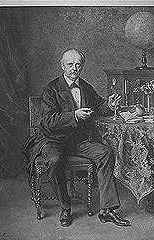 Hermann von Helmholtz 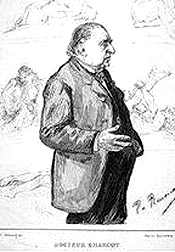 Jean-Martin Charcot  Claude Bernard Images courtesy of the Blocker History of Medicine Collections, Moody Medical Library, Univ. Texas Med. Branch, Galveston
|
1900 - 19501900 - Charles Scott Sherrington states that cerebellum is head ganglion of the proprioceptive system1900 - M. Lewandowsky coins the term "blood-brain barrier" (Bluthirnschranke) [ref: Aschner and Kerper, Mol. Biol. and Tox. of Metals, 2000] 1902 - Julius Bernstein proposes membrane theory for cells 1902 - Physiologist Ida Hyde is the first woman elected to the American Physiological Society 1902 - Oskar Vogt and Cecile Vogt coin the term "neurophysiology" 1903 - Ivan Pavlov coins the term conditioned reflex 1903 - Alfred Walter Campbell studies cytoarchitecture of anthropoid cerebral cortex 1904 - Procaine is synthesized 1904 - Thomas Elliott suggests that autonomic nerves may release chemical transmitters 1905 - Alfred Binet and Theodore Simon have their first intelligence test 1905 - John Newport Langley coins the phrase "parasympathetic nervous system" 1905 - Austrian ophthalmologist Eduard Zinn performs the first successful human corneal transplant 1906 - Alois Alzheimer describes presenile degeneration 1906 - Golgi and Cajal-Nobel Prize-Structure of the Nervous System 1906 - Sir Charles Scott Sherrington publishes The Integrative Action of the Nervous system that describes the synapse and motor cortex 1907 - Ross Granville Harrison describes tissue culture methods 1907 - John Newport Langley introduces the concept of receptor molecules 1908 - Vladimir Bekhterew describes the superior nucleus of the vestibular nerve (Bekhterew's nucleus) 1908 - Victor Alexander Haden Horsley and Robert Henry Clarke design stereotaxic instrument 1908 - Willem Einthoven makes string galvanometer recordings from the vagus nerve 1908 - Oberga introduces the cisterna puncture, a method to access the cerebrospinal fluid through the cistena magna 1908 - Eugen Bleuler coins the term schizophrenia 1909 - Tetrodotoxin isolated from the pufferfish and named by Yoshizumi Tahara 1909 - Harvey Cushing is first to electrically stimulate human sensory cortex 1909 - Korbinian Brodmann describes 52 discrete cortical areas 1909 - Karl Jaspers publishes General Mental Illness 1910 - Emil Kraepelin names Alzheimer's disease 1911 - Allvar Gullstrand-Nobel Prize-Optics of the eye 1911 - George Barger and Henry Dale discover norepinephrine (noradrenaline) 1912 - Original formula for the intelligence quotient (IQ) developed by William Stern 1913 - Santiago Ramon y Cajal develops gold chloride-mercury stain to show astrocytes 1913 - Edwin Ellen Goldmann finds blood brain barrier impermeable to large molecules 1913 - Edgar Douglas Adrian publishes work on all-or-none principle in nerve 1913 - Walter Samuel Hunter devises delayed-response test 1914 - Robert Barany-Nobel Prize-Vestibular apparatus 1914 - Henry H. Dale isolates acetylcholine 1915 - J.G. Dusser De Barenne describes activity of brain after strychnine application 1915 - Walter B. Cannon coins the term "fight or flight" in his book Bodily Changes in Pain, Hunger, Fear and Rage: An Account of Recent Researches into the Function of Emotional Excitement 1915 - Aspirin becomes available without a prescription 1916 - Richard Henneberg coins the term cataplexy 1916 - George Guillain, Jean Alexander Barre and Andre Strohl describe an acute inflammatory demyelinating polyneuropathy (Guillain-Barre Syndrome) 1916 - Shinobu Ishihara publishes a set of plates to test color vision 1916 - Lewis M. Terman publishes The Measurement of Intelligence 1918 - Walter E. Dandy introduces the ventriculography 1918 - Ernst Moro describes a baby's defensive reflex to slapping a pillow on both sides of the infant's head ("Moro reflex") 1919 - Cecile Vogt describes over 200 cortical areas 1919 - Walter E. Dandy introduces the air encephalography 1919 - Gordon Morgan Holmes localizes vision to striate area 1919 - Pio del Rio Hortega divides neuroglia into microglia and oligodendroglia 1919 - Konstantin Tretiakoff describes changes in the substatia nigra in people with Parkinson's disease 1920 - Society of Neurological Surgeons is founded 1920 - Henry Head publishes Studies in Neurology 1920 - Stephen Walter Ranson demonstrates connections between the hypothalamus and pituitary 1920 - John B. Watson and Rosalie Rayner publish experiments about classical conditioning of fear (Little Albert experiments) 1921 - Otto Loewi publishes work on Vagusstoff 1921 - Hermann Rorschach develops the inkblot test 1921 - John Augustus Larsen and Leonard Keeler develop the polygraph 1921 - del Rio Hortega describes microglia 1922 - Army Medical Library established (was the Library of the Surgeon General's Office) 1923 - Capgras syndrome described by Jean Marie Joseph Capgras 1924 - Charles Scott Sherrington discovers the stretch reflex 1924 - Hans Berger records the first human electroencephalogram (EEG) 1925 - C. von Economo and G.N. Koskinas revise Brodmann's cortical nomenclature of the cerebral cortex 1926 - Percival Bailey and Harvey Cushing publish paper describing more the 2,000 neuroepithelial neoplasms 1927 - Chester William Darrow studies galvanic skin reflex in US 1928 - Dorothy Klenke Nash becomes the first female neurosurgeon to practice in the United States 1928 - Philip Bard suggests the neural mechanism of rage is in the diencephalon 1928 - Walter Rudolph Hess reports "affective responses" to hypothalamic stimulation 1928 - John Fulton publishes his observations (made in 1926 and 1928) of the sounds of blood flowing over the human visual cortex 1929 - Hans Berger publishes his findings about the first human electroencephalogram 1929 - Karl Lashley defines "equipotentiality" and "mass action" 1927 - J. Wagner-Jauregg - Nobel Prize-Malaria to treat dementia paralyses 1928 - Edgar Douglas Adrian publishes The Basis of Sensation 1929 - Joseph Erlanger and Herbert Spencer Gasser publish work on the correlation of nerve fiber size and function 1929 - Walter B. Cannon coins the term homeostasis 1930 - John Carew Eccles shows central inhibition of flexor reflexes 1931 - Ulf Svante von Euler and J.H. Gaddum discover substance P 1932 - Max Knoll and Ernst Ruska invent the electron microscope 1932 - Jan Friedrich Tonnies develops ink-writing EEG machine 1932 - Edgar Douglas Adrian and Charles S. Sherrington share Nobel Prize for work on the function of neurons 1932 - Jan Friedrich Toennies and Brian Matthews design the differential amplifier 1932 - Smith, Kline and French introduce the first amphetamine, Benzedrine 1933 - Ralph Waldo Gerard describes first experimental evoked potentials 1934 - S. Howard Bartley performs studies on cortical visual evoked potentials in rabbits 1935 - Ward C. Halsted establishes the first clinical neuropsychological laboratory in the United States 1935 - Dexedrine (an amphetamine) introduced to treat narcolepsy 1935 - Frederic Bremer uses cerveau isole preparation to study sleep 1935 - Stroop Test developed 1935 - Jan Friedrich Toennies develops a five-channel ink-writing EEG 1936 - Egas Moniz publishes work on the first human frontal lobotomy 1936 - Henry Hallett Dale and Otto Loewi share Nobel Prize for work on the chemical transmission between nerves 1936 - Walter Freeman performs first lobotomy in the United States 1937 - James Papez publishes work on limbic circuit 1936 - Massachusetts General Hospital has first EEG laboratory 1937 - Heinrich Kluver and Paul Bucy publish work on bilateral temporal lobectomies 1937 - James W. Papez develops "visceral theory" of emotion 1937 - John Zachary Young suggests that the squid giant axon can be used to understand nerve cells 1937 - Julius Steinfeld publishes report of using insulin shock to treat schizophrenia 1938 - Isador Rabi coins term "magnetic resonance" 1938 - B.F. Skinner publishes The Behavior of Organisms that describes operant conditioning 1938 - Albert Hofmann synthesizes LSD 1938 - Phenobarbital is approved for use by the US Food and Drug Administration 1938 - The Journal of Neurophysiology is first published 1938 - Ugo Cerletti and Lucino Bini treat human patients with electroshock 1938 - Franz Kallmann publishes The Genetics of Schizophrenia 1938 - "Ames Room" designed by Adelbert Ames, Jr. 1939 - Wechsler Adult Intelligence Scale developed 1939 - Carl Pfaffman describes directionally sensitive cat mechanoreceptors 1939 - Nathaniel Kleitman publishes Sleep and Wakefulness 1939 - The Eastern EEG Association (Society) is formed 1941 - Chloral hydrate (a sedative) is approved for use by the US Food and Drug Administration 1942 - Judith Graham develops a KCl-filled glass electrode for recording muscle fiber resting membrane potential 1942 - Stephen Kuffler develops the single nerve-muscle fiber preparation 1943 - John Raymond Brobeck describes hypothalamic hyperphasia 1944 - Joseph Erlanger and Herbert Spencer Gasser share Nobel Prize for work on the functions of single nerve fiber 1944 - Leo Kanner coins the term autism 1946 - Theodor Rasmussen describes the olivocochlear bundle (bundle of Rasmussen) 1946 - President Truman signs the National Mental Health Act 1947 - The American Society of Electroencephalography is founded 1947 - German neurologist Joachim Bodamer coins the term "prosopagnosia" (face blindness) 1948 - The World Health Organization is founded 1949 - Kenneth Cole develops the voltage clamp 1949 - A.C.A.F. Egas Moniz-Nobel Prize-Leucotomy to treat certain psychoses 1949 - Walter Rudolph Hess receives Nobel Prize for work on the "Interbrain" 1949 - Horace Winchell Magoun defines the reticular activating system 1949 - John Cade discovers that lithium is an effective treatment for bipolar depression 1949 - Giuseppi Moruzzi and Horace Winchell Magoun publish Brain Stem Reticular Formation and Activation of the EEG 1949 - Wechsler Intelligence Scale for Children is published 1949 - The Journal of EEG and Clinical Neurophysiology begins publication 1949 - National Institute of Mental Health is formally established 1949 - Donald Olding Hebb publishes The Organization of Behavior: A Neuropsychological Theory |
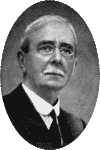 Charles Scott Sherrington Courtesy of the National Library of Medicine.
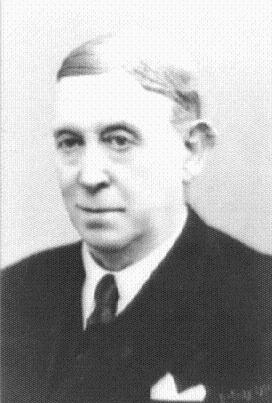 Egas Moniz Courtesy of the National Library of Medicine
|
1950 - present1950 - National Science Foundation is created by Public Law 81-5071950 - Seconal (barbituate; antianxiety medication) is approved for use by the US Food and Drug Administration 1950 - Karl Lashley publishes In Search of the Engram 1950 - Eugene Roberts and J. Awapara independently identify GABA in the brain 1950 - The National Institute of Neurological Disorders and Stroke established (it has gone through several name changes) 1950 - French chemist Paul Charpentier synthesizes chlorpromazine, an antipsychotic drug 1950 - Wilder Penfield published the book The Cerebral Cortex of Man 1951 - MAO-inhibitors introduced to treat psychotics 1951 - B.F. Skinner describes shaping in a paper titled How to Teach Animals 1952 - The Diagnostic and Statistic Manual of Mental Disorders (DSM) is published by the American Psychiatric Association 1953 - Brenda Milner discusses patient HM who suffers from memory loss after hippocampal surgery 1953 - Eugene Aserinski and Nathaniel Kleitman describe rapid eye movements (REM) during sleep 1953 - Serpasil (reserpine; an antipsychotic drug) is approved for use by the US Food and Drug Administration 1953 - H. Kluver and E. Barrera introduce Luxol fast blue MBS stain 1953 - Stephen Kuffler publishes work on center-surround, on-off organization of retinal ganglion cell receptive fields 1953 - James Watson and Francis Crick publish paper revealing the molecular structure of DNA 1953 - Dilantin (phenytoin; an antiepileptic drug) is approved for use by the US Food and Drug Administration 1954 - James Olds describes rewarding effects of hypothalamic stimulation 1954 - John Lilly invents the "isolation tank" 1954 - Thorazine (chlorpromazine; an antipsychotic drug) is approved for use by the US Food and Drug Administration 1954 - Chlorpromazine is approved by the U.S. Food and Drug Administration 1955 - Wechsler Adult Intelligence Scale is published 1955 - Ritalin (methylphenidate; a mild stimulant) is approved for use by the US Food and Drug Administration 1956 - L. Leksell uses ultrasound to examine the brain 1956 - National Library of Medicine named (was the Army Medical Library) 1956 - Rita Levi-Montalcini and Stanley Cohen isolate and purify nerve growth factor 1957 - W. Penfield and T. Rasmussen devise motor and sensory homunculus 1957 - The American Medical Association recognizes alcoholism as a disease 1958 - Paul Janssen develops haloperidol as a neuroleptic drug 1959 - P. Karlson and M. Lusher coin the term "pheromone" 1960 - Ro 5-0690 (Librium), the first benzodiazepine, is approved by the FDA 1960 - Oleh Hornykiewicz shows that brain dopamine is lower than normal in Parkinson's disease patients 1961 - Georg Von Bekesy awarded the Nobel Prize for his work on the function of the cochlea 1961 - Levadopa successfully treats parkinsonism 1961 - Elavil (amitriptyline; an antidepressant drug) is approved for use by the US Food and Drug Administration 1961 - International Brain Research Organization founded 1962 - Eldon Foltz performs the first cingulotomy to treat chronic pain 1963 - John Carew Eccles, Alan Lloyd Hodgkin and Andrew Fielding Huxley share Nobel Prize for work on the mechanisms of the neuron cell membrane 1963 - Valium (diazepam; an antianxiety drug) is approved for use by the US Food and Drug Administration 1964 - Psychobiology Department founded at the University of California, Irvine 1965 - Ronald Melzack and Patrick D. Wall publish gate control theory of pain 1965 - Drug Abuse Control Act 1966 - Department of Neurobiology founded at Harvard Medical School 1967 - Ragnar Arthur Granit, Halden Keffer Hartline and George Wald share Nobel Prize for work on the mechanisms of vision 1967 - Haldol (haloperidol; an antipsychotic drug) is approved for use by the US Food and Drug Administration 1967 - International Neuropsychological Society established 1968 - Alexander Romanovich Luria publishes The Mind of a Mnemonist; A Little Book About a Vast Memory 1968 - National Eye Institute is established 1968 - The National Institute of Neurological Diseases is renamed the National Institute on Neurological Disorders and Stroke 1968 - Tegratol (carbamazepine; an antiepileptic drug) is approved for use by the US Food and Drug Administration 1969 - D.V. Reynolds describes the analgesic effect of electrical stimulation of the periaqueductal gray 1969 - The Society for Neuroscience is formed 1970 - Julius Axelrod, Bernard Katz and Ulf Svante von Euler share Nobel Prize for work on neurotransmitters 1971 - The first annual meeting of the Society for Neuroscience is held in Washington, D.C. 1971 - Godfrey N. Hounsfield develops x-ray computed tomography 1972 - Jennifer LaVail and Matthew LaVail use horseradish peroxidase to study axonal transport 1973 - Candace Pert and Solomon Snyder demonstrate opioid receptors in brain 1973 - Sinemet is introduced as a treatment for Parkinson's disease 1973 - Konrad Z. Lorenz, Nikolaas Tinbergen and Karl von Frisch share Nobel Prize for work on ethology 1973 - Timothy Bliss and Terje Lomo describe long-term potentiation 1973 - M.E.Phelps, E.J.Hoffman and M.M.Ter Pogossian develop first PET scanner 1974 - National Institute on Drug Abuse established 1974 - National Institute on Alcohol Abuse and Alcoholism established 1974 - International Association for the Study of Pain founded 1974 - John Hughes and Hans Kosterlitz discover enkephalin 1974 - First NMR image (a mouse) is taken 1975 - John Hughes and Hans Kosterlitz publish work on enkephalins 1975 - Nembutol (pentobarbital sodium; a barbiturate drug) is approved by the US Food and Drug Administration 1975 - Loxitane (loxapine; an antipsychotic drug) is approved by the US Food and Drug Administration 1975 - Klonopin (clonazepam; an antiepileptic drug) is approved by the US Food and Drug Administration 1976 - Choh Hao Li and David Chung publish work on beta-endorphin 1976 - Erwin Neher and Bert Sakmann develop the patch-clamp technique 1977 - Roger Guillemin and Andrew Victor Schally share Nobel Prize for work on peptides in the brain 1980 - Mental Health Systems Act of 1980 is signed by Jimmy Carter 1981 - David Hunter Hubel and Torsten N. Wiesel-Nobel Prize-visual system 1981 - Roger Wolcott Sperry awarded Nobel Prize-functions brain hemispheres 1981 - Xanax (alprazolam; an antianxiety drug) is approved by the US Food and Drug Administration 1982 - Bengt Ingemar Bergstrom, John Robert Vane and Sune K. Bergstrom awarded Nobel Prize for the discovery of prostaglandins 1982 - Halcion (triazolam; an antianxiety drug) is approved by the US Food and Drug Administration 1983 - A genetic test for Huntington's disease is announced 1986 - Stanley Cohen and Rita Levi-Montalcini awarded Nobel prize for their work on the control of nerve cell growth 1987 - Fluoxetine (Prozac) introduced as treatment for depression 1990 - U.S. President George Bush declares the decade starting in 1990 the "Decade of the Brain" 1991 - Erwin Neher and Bert Sakmann share the Nobel Prize for their work on the function of single ion channels 1992 - National Institute on Drug Abuse becomes part of the National Institutes of Health 1992 - Giacomo Rizzolatti describes mirror neurons in area F5 of the monkey premotor cortex 1993 - The genetic code responsible for Huntington's disease is identified 1994 - Alfred G. Gilman and Martin Rodbell share the Nobel Prize for their discovery of G-protein coupled receptors and their role in signal transduction 1997 - Stanley B. Prusiner awarded the Nobel Prize for the discovery of prions; a new biological principle of infection 2000 - American Psychological Association launches the Decade of Behavior campaign 2000 - Arvid Carlsson, Paul Greengard and Eric Kandel share the Nobel Prize for their discoveries concerning signal transduction in the nervous system 2004 - Linda B. Buck and Richard Axel share the Nobel Prize for their discoveries about odorant receptors and the organization of the olfactory system 2006 - The term "optogenetics" first appears in a publication 2013 - The start of the Human Brain Project is announced 2013 - James Rothman, Randy Schekman, and Thomas Sudhof share the Nobel Prize for their discoveries about the machinery regulating vesicle traffic 2013 - US President Barack Obama announces the Brain Research through Advancing Innovative Neurotechnologies (BRAIN) Initiative 2014 - John O'Keefe, Edvard Moser, and May-Britt Moser share the Nobel Prize for their discoveries about cells that constitute a positioning system in the brain 2017 - Jeffery C. Hall, Michael Rosbash and Michael W. Young share the Nobel Prize for their discoveries of molecular mechanisms controlling the circadian rhythm 2021 - David Julius and Ardem Patapoutian share the Nobel Prize for discoveries of receptors for temperature and touch |
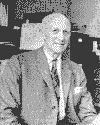 Wilder Penfield   Roger Sperry Courtesy of the Archives California Institute of Technology |
Try it! |
Do you like interactive word search puzzles? Make sure your
browser is "java-enabled" and try these:
|
|
References:
|
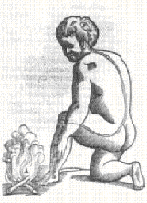 Image courtesy of the National Library of Medicine |
For more information, see: